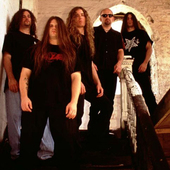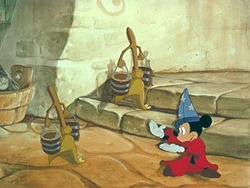This was the Metal Blade Records 25th Anniversary Tour package that Disney prophylactically evicted from the HoB venues on its Anaheim and Orlando property. (See my LA Times article here.) And I have a theory about why.
First, let’s not forget that the censorship was levied by Disney’s command; HoB is no foe to either heavy metal or Satan. The Sunset Boulevard location that hosted this Cannibal Corpse show, in fact, was built to echo the cotton gin outside Clarksdale, Mississippi, where Robert Johnson is supposed to have sold his soul to the devil in exchange for his unearthly guitar skills; it even incorporates tin roofing from that legendary shack, and its interior is decorated in a voodoo motif. Many are the satanic performers I have beheld on House of Belial stages, from Marilyn Manson in Orlando to Children of Bodom in Anaheim to Rob Halford in West Hollywood. (Lana Clarkson met Phil Spector at that very establishment following the Halford show, by the way.) The club’s acronym reads as “hob,” a Middle English contraction of hobgoblin; Hob is also a British diminutive of Robert, as in Johnson. And last year, the House of Beelzebub chain was acquired by the entertainment monopoly that many consider the Great Satan, LiveNation (formerly Clear Channel).
But which is the Greater Satan, LiveNation or Disney? In attempting to trump Satan via its metal ban, Disney has made a mockery of the House of Blues motto, “Unity in diversity.” The Walt-Mart Co. is all for unity through domination, though, and it normally wants a piece of anything that generates lucre, including heavy metal.
That omnivorous appetite has resulted in a metallic clash before. On the Disney-owned Hollywood Records at the turn of the millennium, metal’s own Glenn Danzig (“Am I Demon?,” “Satan’s Child,” “I Luciferi,” etc., etc.) released an album called “Blackacidevil.” As will happen with a huge conglomerate, the right hand didn’t know where the Left-Hand Path was leading; when the corporate heads found out, Danzig’s first album for the label became his stillborn last. To this day, Disney remains unprepared for the public to associate hell with Tinker Bell.
At least not directly. Disney writhes deep in Satan’s sheets, but prefers to purvey His message via the traditional link of Mouse and Mammon rather than let a Danzig or a Cannibal Corpse confuse the issue. Those two and other metal artists, both Disney and LiveNation are beginning to realize, act as double agents, pretending to represent cartoonish entertainment villains (like Maleficent in “Sleeping Beauty”), but actually advancing a far more subversive agenda of individualism and personal freedom.
Metal philosophy thus competes with conformist commerce, and commerce’s interests are best served by ploys such as the mega-successful “High School Musical” Disney Channel TV movies, the second of which came out last month. The “HSM” creators show true genius in walking a razor’s edge between pablum and parody, portraying the goody-goody protagonists as grinning dolts and giving the best actors the parts of the schemesters/tricksters/devils, who come off as both more intelligent and more fun. The underlying message: Playing fair is stupid; materialism rules. My teenage daughter and her friends laugh at “High School Musical,” yet watch it every chance they get. They’re all taking the E-ticket ride to Erebus.
The Disney-adjacent Mouse of Blues clubs bowed to pressure from Disney, which didn’t so much fear that visiting pups would be exposed to scary-looking metal fans or to naughty words emanating from the stage; it feared competition. What we have is a turf war, with Disney simultaneously plucking the anti-authority viper (metal) from its breast and battling one of its own biggest rivals (LiveNation). (Stock-market gamblers, watch for a merger of natural allies.)
The only thing I can’t figure out is why the action had to be taken so precipitously, embarrassing the innocent Mouse of Blues venues -- though from Disney’s perspective, squashing them sure must have felt good. Instead of a bloodbath inflicted upon existing dates, a simple cessation of future metal bookings would have attracted far less attention and avoided the loss of millions in revenue from pissed-off metalheads, many of whom actually spend their minimum wages in the Black Magic Kingdom.
There is a rumor that rap will also be banned from Disney property, or maybe already has been. (No hip-hop acts are currently scheduled on the two Mouse of Blues calendars.) Talk about Helter Skelter -- there’s a trend that reeks with, shall we say, even darker implications.
Because Disney is so much more duplicitous and therefore more dangerous than buy-everybody Clear Channel, the title of Greater Satan clearly belongs to Disney. The writing was on the wall way back in 1940, in the animated film “Fantasia,” the keynote of which was Mickey Mouse himself playing the Sorceror’s Apprentice. Few will be surprised to learn that Mickey has risen steadily through the ranks, from apprentice to sorceror to . . .
* * *
 I forgot my excuse for all this speculation -- which is fully sanctioned, of course, by the New World Order and Skull and Bones, of which I am an executive officer.
I forgot my excuse for all this speculation -- which is fully sanctioned, of course, by the New World Order and Skull and Bones, of which I am an executive officer.
Oh yeah, I was gonna review the Cannibal Corpse caravan, which, just like Lucifer, was thrown out of Disney heaven on both coasts. And I learned a lot at the show.
One old lesson I was glad to have reinforced was that bands onstage are often substantially different from their records. My first clue about Florida’s the Absence was the guy in the audience wearing the Iron Maiden T-shirt. While the Absence’s new CD, “The Plague” (produced by Jonas Kjellgren), would lead one to expect a balance of old and new metal, their live manifestation leaned further toward old, with the Maidenish twin-guitar melodies assuming the phalanx. Nothing wrong with that; drummer Jeramie Kling’s rhythm charged hard, and the group got a much stronger crowd response than most openers. Getting a little heavier by closing with Testament’s “Into the Pit” was a good idea. I liked the Absence a lot, but I must scold energetic, wiry little vocalist Jamie Stewart and company for their beards. Until an advanced age, almost no man is ugly enough that a bush of facial hair improves his appearance. I know you wanna project a certain image, but what you’re really doing is driving women away, and I prefer to keep them around.
On record, Goatwhore didn’t seem blended enough, just shards of instruments crashing against one another. Maybe they’ve had time to settle into the material; the rhythm shifts sounded more natural, and there was more depth to the thrash. Vocally, the shriek of guitarist Sammy Duet contrasted hard and right with the lower rasp of tall skinny old goat frontman Ben Falgoust. Big pit action. A growing band.
Watching the Red Chord (whose record I reviewed last week) and their radioactive audience, I kept thinking, damn, kids these days are really getting hopped up for the avant-garde jazz. In the pissoir afterward, some guy mumbled, “They put too many things together and make it sound good” -- make it two of those, waiter. The impression was five guys hitting separate beats in such perfect sequence that they sounded like a continuum -- isn’t digital sound something like that? Makes yer head spin. And they were equally mixed-up to look at. Clean-cut T-shirted voxman Mike Kozowyk came off like a cheerful jock and was somehow able to make a voice come out of the PA even when he wasn’t near the mike and neither was anyone else. Drummer Brad Fickeisen had a sharp chinline beard; bassist Greg Weeks had a fuller one to go with the full-on crazy look in his eye. Guitarist Mike McKenzie had a Socrates beard and played left-handed, doing semisynchronized ax-lifts with bounce-around new guitarist Mike Keller, who had a black Beatle bob and no beard cuz he looked about 10 years old. A kid in the crowd surfed belly-up on a sea of upturned palms as the music created torso vibrations throughout the room. Abstract as hell, different every five seconds, but everybody was going Whu? Wha! There were twice as many people digging it in this room as you’d figure would exist in the whole country. Evolution.
The Black Dahlia Murder was another band that turned around my preconceptions. Too much double kick? Yeah, but the punishing energy of that drummer (Shannon Lucas?), who squatted low behind his kit like a giant lobotomized toad and just killed, had major effect, even if by now there was no room on the floor to accomplish a circle pit. These guys looked like a bunch of geeks and were all the more effective because they lacked rockstarness. Main force: front man Trevor Strnad, pouncing around shirtless with his considerable gut shaking, mike cord whipping and sweat flying off his head in perfect time with the rhythm accents. Dude had something major figured out, which was that if the beat wasn’t particularly defined, he could make the music comprehensible by barking out evenly spaced divisions. A conductor is what he was.
Cannibal Corpse were among the inventors of humpa-humpa thrash, and they continue to do it better than anybody else. They stood there erect like nobody better fuck with ‘em, and I sure wouldn’t. There was some female participation among the audience, so Paul Mazurkiewicz and Alex Webster must have expelled some hormones in sync while beating skins and bass -- a chemical thing developed over time, like Slayer. And y’know, they call orgasm the little death.

